
When you go shopping, you must have noticed the price labels on the products. Those products can be food items, beverages, household items, etc. Or, when you are out shopping for clothes, you may have noticed the price tags hanging on a particular clothing item. These are non-adhesive labels.
Nonetheless, when a label is torn by rough handling, it loses its identity. Everything gets messed up. Suppose you have taken hours to choose the product of your desire, and when you finally choose it. When you are there at the payment counter for the payment procedure, the counter person refuses to give you that product. Why? Because he doesn’t know the price and barcode of that particular product. However, without both of these things, you won’t be able to get that particular product.
Moreover, non-adhesive tags are better than adhesive labels, but not all are the best. That’s where it makes a huge difference.
However, if you are planning to buy non-adhesive labels in bulk, consider a reliable non-adhesive label supplier. Or, if you are looking forward to trading these non-adhesive labels, consider going for a trustworthy non-adhesive label exporter. So, grow your business and dominate the business world.
In this ultimate guide, we are going to discuss how to choose the right non-adhesive label for your product packaging. So, let’s begin.
Normal papers work fine in non-adhesive labels until they get torn, wet, or fall off. The right material needs real toughness to withstand any rough handling. If someone accidentally pulls them off, they should stay in their original place. In other words, they should not get damaged by any means. However, Kraft paper strengthened with fiberglass works amazingly. For those who don’t know what Kraft paper is, let us tell you. Kraft paper is usually brown paper used in different industries.
Normal paper labels work best, but they tear easily. They are best for indoor use. Artificial materials such as polypropylene and polyester are resistant to water and chemicals. They even stay/remain in high temperatures. At the same time, Vinyl is good for outdoor exposure.
Production facilities need tags that can withstand oil, water, and rough handling. The barcode says it all. If one tag is torn or lost, it leads to a lost package. (if readability is gone). Therefore, hang tags are ace in such situations. FDA standards are necessary; they handle refrigeration and moisture. However, sometimes, they also play a major role in humidity and sometimes in cooking processes.
These non-adhesive labels are mostly used by industries and applications. Producers mostly use robust synthetics or reinforced papers to use the tags in equipment. However, food and beverage manufacturers also use these non-adhesive labels with fruit labels for numerous reasons. Besides, they also use them to increase their brand appeal.
High-quality materials mostly cost less in the long run. If the label fails and you don’t replace it, it causes many problems, including operational issues. However, it is not necessary that if a label is costly, it will function nicely. The good functioning of a label depends on the different factors, as we have mentioned above. Set a goal of getting the best non-adhesive label for your product packaging, and that’s all.
A tag or label may not look very necessary until you actually need it. The right non-adhesive label always keeps the necessary information intact. However, customers are happy and satisfied. This is why making the right decision is very necessary. In order to choose between self-adhesive and non-adhesive labels, you should read this blog on Self-Adhesive vs Non-Adhesive Labels Comparison to get the best products based on your needs.
Identify Products: Without the need for adhesion.
Provide Information: Information such as the price of a product, its brand, barcodes, or instructions to follow about a particular product. For example, if you buy a T-shirt, there are instructions written on its tag on how to treat that particular fabric.
If you ever visit a patient in a hospital, you may have noticed a non-adhesive label on their wrist. This label is to identify a particular patient in the hospital. As there are many patients in the hospital, this is a way to recognize a particular patient. However, it is especially for sensitive skin.
Non-adhesive labels have a huge psychological impact on consumer behavior. For example, when we are out shopping and look at a product’s tag, we decide whether we have to buy it or not. There are many factors of it. At the same time, some are its price and brand.
Non-adhesive labels not only contain practicality but also have visual appeal. Different non-adhesive tags come in different colors, designs, and patterns, which attract the customer at first glance.
So, that’s it. We have provided you with enough information about how to choose the right non-adhesive label for your product packaging. In this comprehensive guide, we have covered all the points that you need to know.
When you go shopping, you must have noticed the price labels on the products. Those products can
READ FULLWhen you go shopping, you must have noticed the price labels on the products. T
READ FULLLabels are crucial with respect to any scene of modern packaging, logistics, re
READ FULL